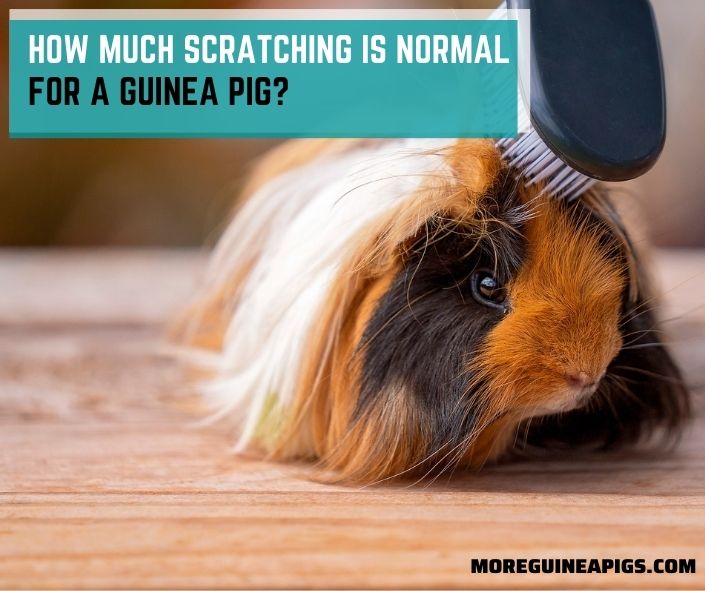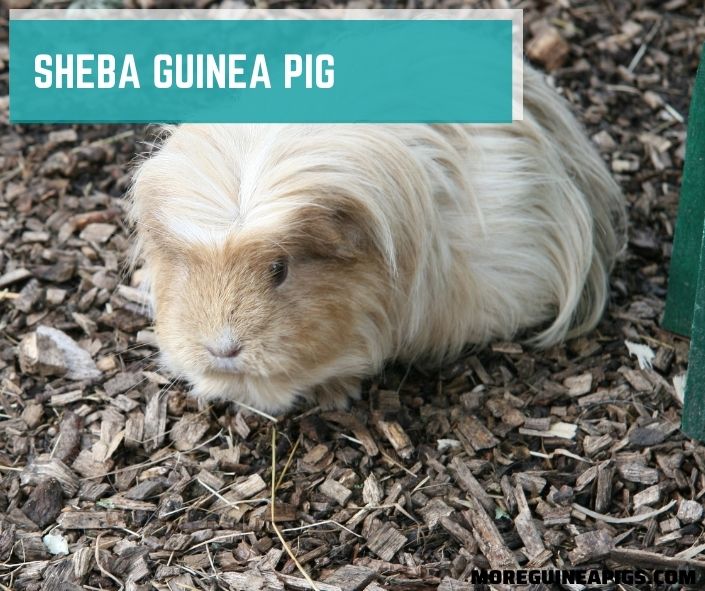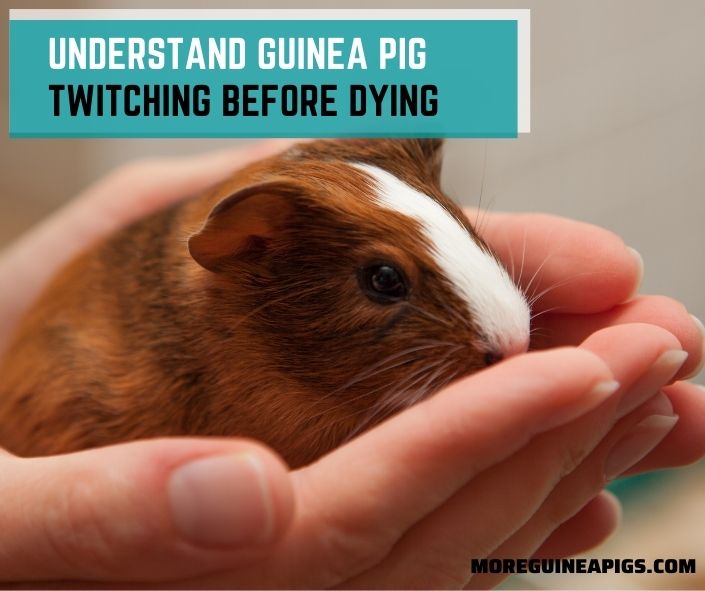The Ultimate Guide to Hairless Guinea Pigs
People who develop allergic reactions to long-haired cats are likely to have allergies to long-haired guinea pigs as well. For this reason, owning a hairless guinea pig is the best alternative.
Although to some extent hairless guinea pigs can reduce the risk of allergic reactions to the least minimum, it is not true that hairless guinea pigs do not cause allergies or that they are hypoallergenic.
This is because the substances that people are allergic to are not contained in their hair, rather, they’re contained in their saliva, urine, and gland secretions.
In other instances, people who find it difficult to meet up with grooming demands may want to opt-in for hairless guinea pigs. This is a great choice for owners who really don’t have ample time for regular grooming.
Whatever is the reason you want to own a hairless guinea pig, this article is your best bet. So the question that begs for an answer now is “are hairless guinea pigs ideal for you?” Read on to find out!
In the end, you’ll learn everything about hairless guinea pigs – their appearance, disposition, care level, and what you should take notes of.
All about Hairless Guinea Pigs
Hairless guinea pigs are simply a breed of guinea pigs without hair on their skin. But they may have little hair on their feet, muzzles, and legs, They are otherwise called skinny pigs. Their skin appears to be rubbery with lots of wrinkles and drooping ears.
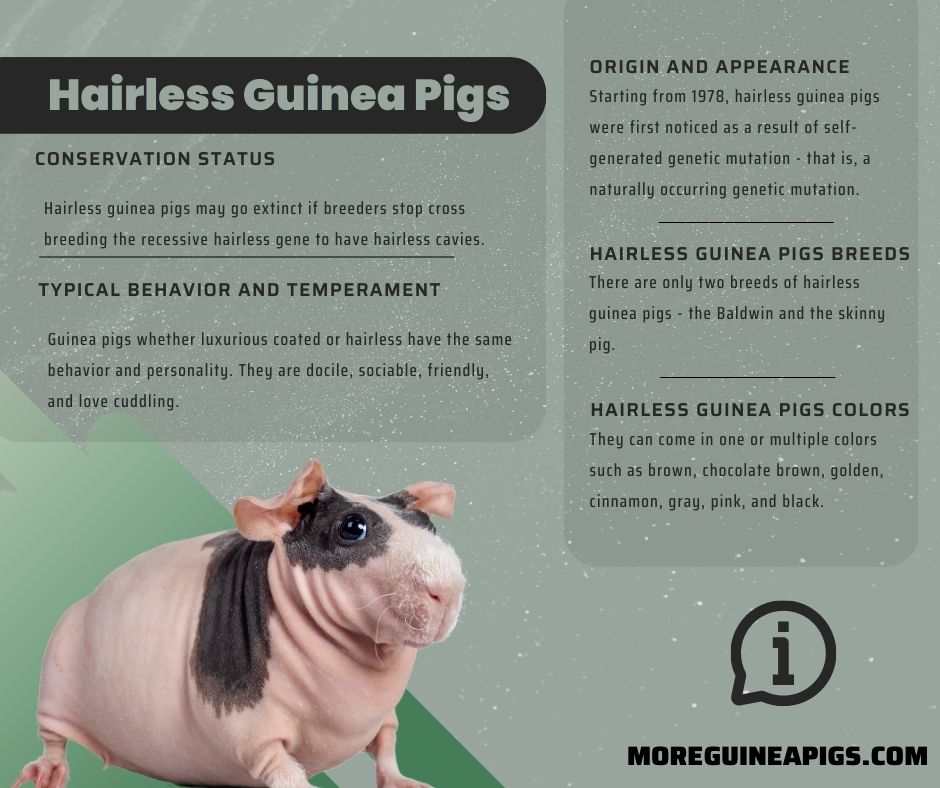
Origin and Appearance
Starting from 1978, hairless guinea pigs were first noticed as a result of self-generated genetic mutation – that is, a naturally occurring genetic mutation.
However, in the 1980s and beyond, they were specially bred for their hairlessness and it has since then become one of the most popular guinea pig breeds.
In terms of origin, guinea pigs are known to come from Peru. But the two breeds of hairless guinea pigs (skinny and Baldwin) have their different history. The skinny hairless guinea pig was created in a lab in Montreal.
After the first natural genetic mutation incident in 1978, scientists then took fancy in breeding a large number of these animals to see the possibility of genetic mutations.
When they identified a genetic mutation that resulted in hairlessness, they pursued this trend and as time went by, new animals were added to the breeding program.
On the flip side, the Baldwin wasn’t lab bred but their breeding was intentional as they were bred for shows.
According to Online Guinea Pig Care, it is believed that they (the Baldwin) “were originally a spontaneous mutation from White Crested cavies belonging to a Californian cavy owner who was breeding them for show.”
As mentioned earlier, these breeds of guinea pigs are hairless on their bodies but have little hair on their legs, feet, and muzzles. They have rubbery-like skin with wrinkles, especially around the neck.
Hairless Guinea Pigs Breeds: What Breeds Are There?
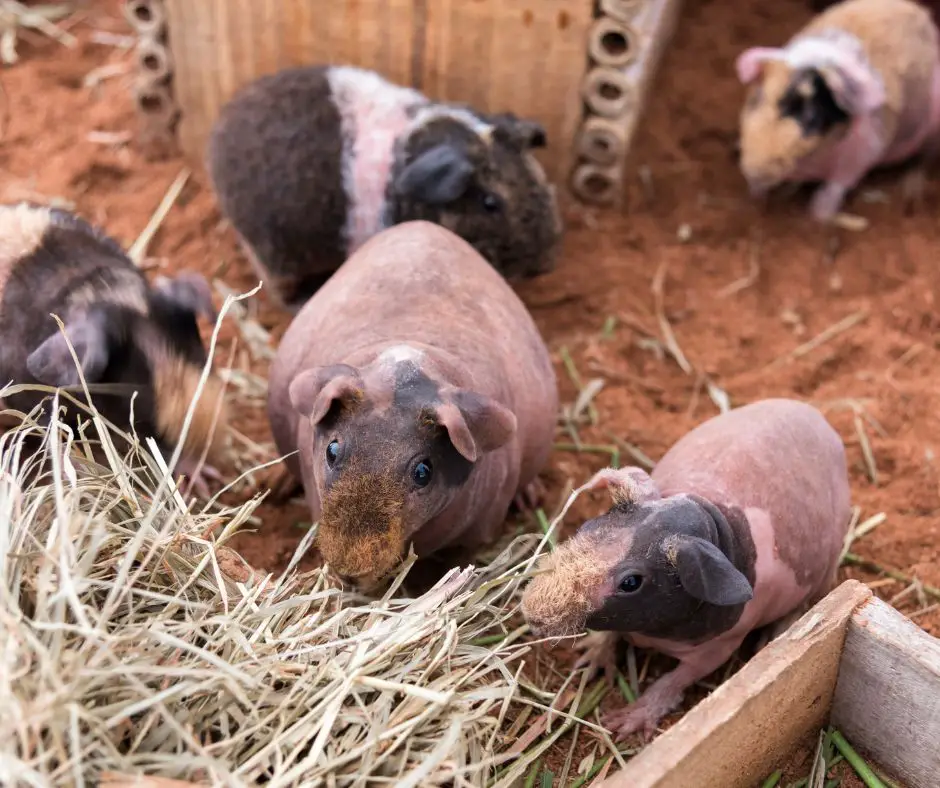
Currently, there are only two breeds of hairless guinea pigs – the Baldwin and the skinny pig. The hairless guinea pigs aren’t different in terms of care needs from the haired breeds. The only difference is that they don’t have thick lustrous coats.
Similarly, between the Baldwin and skinny breeds, their major differences are in how they have hair, and when.
Baldwins are born with hair but this hair tends to fall out gradually over the first few months of their life, and from then on they are completely bald.
However, the skinny pigs are born without hair and they remain that way till adulthood. They may have hair on the ends of their nose and their feet.
Hairless Guinea Pigs Colors
Being born without hair, hairless guinea pigs aren’t less beautiful than their thick-coated counterparts. They can come in one or multiple colors such as brown, chocolate brown, golden, cinnamon, gray, pink, and black.
Also read: 11 Guinea Pig Colors And Specific Morphs
Typical Behavior and Temperament
Guinea pigs whether luxurious coated or hairless have the same behavior and personality. They are docile, sociable, friendly, and love cuddling.
But the hairless breeds are less aggressive and less confrontational. This means that even when kept in groups, they’re less likely to be territorial or less likely to confront and act aggressively towards one another.
Nonetheless, like with every animal, males generally tend to be more aggressive than females. This is because being males, they are more territorial and like to protect their space than females.
Conservation Status

As for hairless guinea pigs, we can’t say whether they’re endangered or extinct since they’re lab engineered. They’re available in large quantities and are gaining popularity among pet lovers.
However, hairless guinea pigs may go extinct if breeders stop cross breeding the recessive hairless gene to have hairless cavies.
Presently, other guinea pigs are not yet extinct. This means that there are still some breeds even in the wild. Although it’s hard to believe, there are still wild guinea pigs in South America, specifically in Brazil, Uruguay, and Argentina.
In Bolivia and Uruguay in Peru, a different species of wild guinea pig, the “Brazilian guinea pig (Cavia aperea)” is still in existence in the wild.
Hairless Guinea Pigs Vs. Other Guinea Pigs
There isn’t much that distinguishes hairless guinea pigs from regular guinea pigs. They are almost the same because they require almost the same care, including the same diet and cage set up.
Ideally, all breeds of guinea pigs require spacious enclosures and a balanced diet of 70% hay, pellets, and vegetables.

Habitat: Cage Set-Up
A perfect guinea pig enclosure must be spacious for your pets to thrive healthily. It should be at least two feet wide by three feet long to be considered spacious.
Since guinea pigs do not climb or use vertical space as much as other small rodents, the cage’s floor space is more important than the vertical height.
Also to note when purchasing or building the cage, avoid using a wire bottom cage. To protect their feet, the cage should have a solid bottom.
Although glass aquariums and plastic tubs may meet the size requirements for an ideal cage, they should be avoided because they restrict adequate ventilation. Open top cages should also be avoided if there are other pets in the house, such as cats and dogs.
Alternatively, you can have a solid plastic bottom with a wire cage top for proper ventilation. Note that if you decide to use an open-top cage, it should be at least 8 -10 inches tall.
Also read: Top 5 Guinea Pig Cages & 7 Factors To Make Perfect Enclosure
Bedding
After you’ve provided it with a suitable cage, you must make it a home by adding beddings and cage accessories like hide houses. Beddings such as pine and cedar should be avoided as they can cause respiratory infection when inhaled.
Even hays as beddings can cause eye irritation if they robbed their face on it. Hence, the best bedding for your hairless guinea pigs cage is the newspaper or any soft paper products.
Also read: 4 Best Guinea Pig Bedding
carefresh 99% Dust-Free Natural Paper Small Pet Bedding with Odor Control
Temperature And Lighting
Interestingly, guinea pigs aren’t reptiles that depend on the external environment to survive. Hence, they need no special heating or lighting in their cages. The temperature of your house is enough for them to thrive.
But ensure that their cage isn’t situated near the window, heat vent, or direct sunlight. This is to avoid overheating as guinea pigs don’t sweat and that can cause serious health issues.
Hairless Guinea Pigs Food
Hairless guinea pigs have the same diet as regular guinea pigs. Their diet is made up of 70% hay. Pellets, fresh vegetables, and fruit can make up the other 30%.
Also, since they require enough vitamin C to enhance their immune system, you should ensure they get enough of it from their diets such as pellets, veggies, and supplements.
Manna Pro Guinea Pig Feed | with Vitamin C
Hairless Guinea Pigs Health Issues
The hair to animals that have hair is a protective covering to their skin, such that when they’re exposed to the sun, it doesn’t have much of an impact on them.
The hairless guinea pigs for their lack of hair are prone to skin disease more than regular guinea pigs. They can suffer from parasites, ringworm, and some other skin infections. For this reason, they need special attention to their skin to keep them healthy.
Aside from giving special care to their skin, there isn’t much that hairless guinea pigs require that is unique to them. They don’t require much, if any, bathing. Bathing them too frequently can cause their skin to dry out.
Hairless Guinea Pigs Breeding
How hairless guinea pigs came about and in large quantities was through careful breeding in the lab.
The gene for hairlessness is a recessive gene which implies that for the babies to be skinny, both parents must have the hairlessness gene.
This in a nutshell means that as an inexperienced or untrained breeder, it’s easy to breed two skinny pigs to have hairless baby cavies.
However, breeding coated guinea pigs with other breeds to get hairless breeds must be done with special care and with thorough research.
Can You Put A Hairless Guinea Pig With A Regular Guinea Pig?
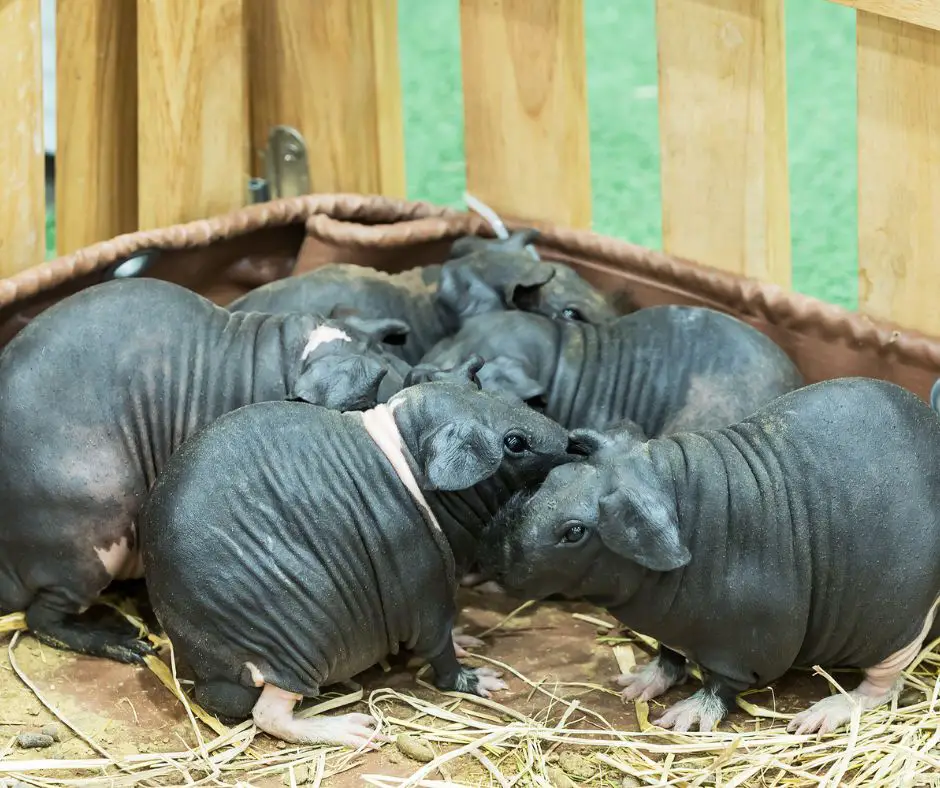
Yes, you can successfully keep a hairless guinea pig with a regular guinea pig. What you should be concerned about is their environmental requirements and diet.
Interestingly, both breeds have the same dietary needs and environmental setup. Hence, you can keep them in the same cage with no issue.
Where Do You Find Skinny Pigs?
Skinny pigs are rare in the wild. They hardly occur naturally in the wild. But in captivity, they are specially bred for their lack of hair. You can get them from pet stores, local breeders, or another pet owner.
How Much is a Skinny Pig?
Even though skinny pigs have been around for a few decades now, their popularity and demand are still on the increase. The more pet lovers choose it over thick-coated breeds, the more it’s increased in price.
Currently, depending majorly on the skin color and perhaps size, you should expect to buy it from around $129 – $200. The more colorful the skin is, the more expensive it is.
Also read: How Much Are Guinea Pigs?
Are Hairless Guinea Pigs Good Pets?
Yes, hairless guinea pigs are good pets, especially to an individual who may not have time for regular grooming. They require little to no grooming and are easy to maintain.
Conclusion
With the hairless breed of guinea pigs becoming increasingly popular, you can now explore the diversity in cavies. The hairless guinea pigs are actually the same species as the regular lustrous-coated guinea pigs you can find in pet stores.
The only difference is that they do not have hairs on their skin. Hairless guinea pigs are easy to care for although they stand the risk of getting skin infections. The hairless guinea pig is a rare breed that has been in the market for about 80 years.
Hairless guinea pigs are friendly and smart creatures. They are also known to be very entertaining pets. Therefore, they make great pets for all categories of pet lovers.





